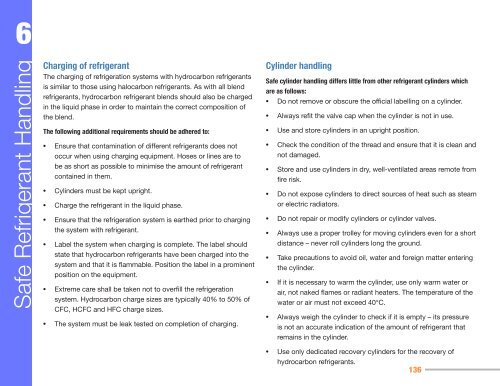Manual for Refrigeration Servicing Technicians - UNEP - Division of ...
Manual for Refrigeration Servicing Technicians - UNEP - Division of ...
Manual for Refrigeration Servicing Technicians - UNEP - Division of ...
You also want an ePaper? Increase the reach of your titles
YUMPU automatically turns print PDFs into web optimized ePapers that Google loves.
6<br />
Safe Refrigerant Handling<br />
Charging <strong>of</strong> refrigerant<br />
The charging <strong>of</strong> refrigeration systems with hydrocarbon refrigerants<br />
is similar to those using halocarbon refrigerants. As with all blend<br />
refrigerants, hydrocarbon refrigerant blends should also be charged<br />
in the liquid phase in order to maintain the correct composition <strong>of</strong><br />
the blend.<br />
The following additional requirements should be adhered to:<br />
• Ensure that contamination <strong>of</strong> different refrigerants does not<br />
occur when using charging equipment. Hoses or lines are to<br />
be as short as possible to minimise the amount <strong>of</strong> refrigerant<br />
contained in them.<br />
• Cylinders must be kept upright.<br />
• Charge the refrigerant in the liquid phase.<br />
• Ensure that the refrigeration system is earthed prior to charging<br />
the system with refrigerant.<br />
• Label the system when charging is complete. The label should<br />
state that hydrocarbon refrigerants have been charged into the<br />
system and that it is flammable. Position the label in a prominent<br />
position on the equipment.<br />
• Extreme care shall be taken not to overfill the refrigeration<br />
system. Hydrocarbon charge sizes are typically 40% to 50% <strong>of</strong><br />
CFC, HCFC and HFC charge sizes.<br />
• The system must be leak tested on completion <strong>of</strong> charging.<br />
Cylinder handling<br />
Safe cylinder handling differs little from other refrigerant cylinders which<br />
are as follows:<br />
• Do not remove or obscure the <strong>of</strong>ficial labelling on a cylinder.<br />
• Always refit the valve cap when the cylinder is not in use.<br />
• Use and store cylinders in an upright position.<br />
• Check the condition <strong>of</strong> the thread and ensure that it is clean and<br />
not damaged.<br />
• Store and use cylinders in dry, well-ventilated areas remote from<br />
fire risk.<br />
• Do not expose cylinders to direct sources <strong>of</strong> heat such as steam<br />
or electric radiators.<br />
• Do not repair or modify cylinders or cylinder valves.<br />
• Always use a proper trolley <strong>for</strong> moving cylinders even <strong>for</strong> a short<br />
distance – never roll cylinders long the ground.<br />
• Take precautions to avoid oil, water and <strong>for</strong>eign matter entering<br />
the cylinder.<br />
• If it is necessary to warm the cylinder, use only warm water or<br />
air, not naked flames or radiant heaters. The temperature <strong>of</strong> the<br />
water or air must not exceed 40°C.<br />
• Always weigh the cylinder to check if it is empty – its pressure<br />
is not an accurate indication <strong>of</strong> the amount <strong>of</strong> refrigerant that<br />
remains in the cylinder.<br />
• Use only dedicated recovery cylinders <strong>for</strong> the recovery <strong>of</strong><br />
hydrocarbon refrigerants.<br />
136

















